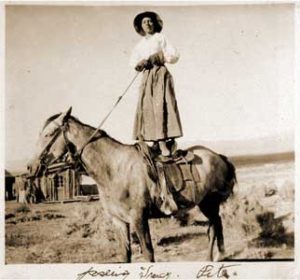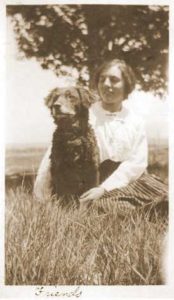
Courtesy Teresa Knight-Bumbardner
TERESA (TRACY) D’ALOSIO KNIGHT
The information below has been compiled from a variety of sources. If the reader has access to information that can be documented and that will correct or add to this woman’s biographical information, please contact the Nevada Women’s History Project.
At A Glance:
Born: June 19, 1891, Eureka, Nevada
Died: September 10, 1987, San Jose, California
Race/Nationality/Ethnic Background: Italian
Married: 1926 to Edward Arthur Knight
Children: Three (two died at birth) Teresa Maria Knight (Bumgardner)
Primary City and County of Residence and Work:
Eureka (Eureka County), Delamar (Lincoln County), Lane City, Steptoe Valley and Ely (White Pine County), California (San Mateo and Santa Clara Counties)
Major Fields of Work: Cowgirl, Housewife
Other Role Identities: Wife, Mother
Born Teresa D’Alosio on June 19, 1891, in Eureka, Nevada, to Italian immigrant parents, Tracy was raised in some of the more remote areas of early eastern Nevada. She was nicknamed Tracy by an older brother, Maurice D’Alosio (John). Her father had come over from Italy to Nevada first. Later, her mother and their two older children followed him.
When Tracy was two, her father was killed. He had been working as a sheep herder because the country was in a recession and the mines were not hiring. It was a time of conflict between the cattle and sheep owners. The cattlemen thought the sheep ate the feed in the grazing land so short that the cattle did not have anything to eat. Her father was found out on the range, shot by his own gun.
In a year or so the family moved with her mother’s sister to the mining town of Delamar in the southeastern part of Nevada, near Caliente. In Delamar, her mother worked as the cook at her sister’s new boarding house. As time passed and new miners arrived, a northern Italian man, John B. Lusetti, came to live in the boarding house. Her mother eventually married him. He bought the boarding house from Tracy’s aunt. Tracy’s aunt and family then moved to California’s Central Valley.
Later in Delamar, Tracy’s mother gave birth to a baby girl. After a few years, the boarding house was sold and Tracy’s family moved on to the small mining town of Lane City in Robinson Canyon, northwest of Ely. There the family ran a store, post office, dairy, and saloon.
In 1901, when Tracy was ten years old, the family moved to a ranch in Steptoe Valley, twenty miles from Ely (on the western side and across the valley from the smelter town of McGill). This ranch is called “The Lusetti Ranch”, after her step-father, John B. Lusetti.

Courtesy Teresa Knight-Bumbardner
She learned many things from the Shoshone Indians who lived nearby. They taught her how to braid horsehair into a rope, and skin rattlesnakes for making into belts. The Indians also taught her many things about the wild plants growing in that area such as which were edible and which were poisonous. She especially loved prickly pear cactus fruit.
Tracy was not afraid of snakes. One time while riding on the range, she found a rattlesnake and killed it. Because it was early in the spring and rattlers usually did not come out at that time in the high mountains, she thought no one would believe she had killed one. She picked the rattler up and put it in her pocket, got back on her horse, and rode home. At home, a man was painting inside the house. When Tracy pulled the snake out of her pocket to show the family, the snake started to curl around her wrist. She quickly shook it off. The painter was so scared he threw a pillow at Tracy and it caused her nose to bleed. The next day the painter went to her stepfather and wanted his pay, for he was quitting. When asked why he wanted to leave, he said he was afraid that Tracy was planning to do something. Indeed she was; she was looking for a snake to put in his paint bucket.
One time during haying the work hands were sleeping in tents. Tracy had found a nest of little water snakes. She tied the snakes in a bunch to the tent pole where the men would grab them going into their tent. The men were not amused. They threatened to throw her in the pond and not come in to get her until she went down three times. (She did not know how to swim.) Fortunately, they never got around to that swimming lesson.
During prohibition, Tracy was at home alone when some government men arrived. She kept them busy talking outside until they left. Luckily so, because in plain view in the kitchen were barrels of fermenting wine.
In 1925 she met and fell in love with Edward Arthur Knight, son of a Cornish mining family. They were married the next year on the ranch by a Catholic priest. They moved to Ely where Arthur worked for the Nevada Northern Railroad as an inspector. The couple’s first two children died at birth – one a premature son, followed the next year by the stillbirth of a tiny daughter. Happily, in 1930, a daughter, Teresa Maria, was added to the family.
When Arthur was out of a job during the Depression of the 1930’s, a Shoshone woman friend of Arthur’s showed him two mines in the mountains on the way to the ranch. One was a tunnel contained gold and silver ore and one was a vertical-shaft lead mine. With their little daughter and one of Arthur’s friends, they moved up in the mountains close to those mines. Later, the friend would leave for another job, leaving Arthur to do the mining tasks alone.
Arthur would ride a bucket down the shaft to bore holes and set and light the dynamite. Then, very fast, he would pull himself up before the dynamite exploded. In the meantime, Tracy would hear the blast and run up the mountain hollering, “Arthur, are you all right?” Then Arthur would run down the hill shouting, “I’m all right. I’m all right.” After a while, the worrying and stress about the mine blasting became unbearable. They decided to make a change.
Arthur joined the government-run Civilian Conservation Corps. He moved Tracy and baby Teresa back to Ely. The CCC kept him away from home a lot, working as a carpenter in the mountain state parks. He had learned to be a carpenter in the Army in WWI. Tracy didn’t like living alone, especially when the baby came down with whooping cough. She had her stepfather write a letter stating that Arthur could have a job on the ranch. (The CCC wouldn’t let men go unless they had another job.) Tracy and family moved to the Lusetti Ranch.
After working on the ranch for a while, Arthur bid on and received a contract with the government to haul mail. They moved back to Ely. Arthur met the evening train from Cobre five times a week and took the mail to the post office in Ely. Then he delivered mail to Ruth and Kimberley before going home at night. The next contract he won was to carry mail down south to Pioche. By this time WWII was beginning. During Christmas time there was so much mail that two pickup trucks were needed to haul it. So Tracy, in her 50’s, learned to drive. She drove one truck and Arthur the other. When that contract ended, Arthur went to work as a carpenter in Ruth, and later McGill, for the rest of the war.
After the war, when daughter Teresa had graduated from White Pine High School (1948), they left Nevada and moved to Half Moon Bay, California, 50 miles south of San Francisco. Tracy was a member of the American Legion Auxiliary in that community. She also had a green thumb. When she took you around her garden it was like she was introducing you to her friends. She remembered when and where she got each plant, how well it had grown, its beautiful color and smell, if you could eat it and how you would cook it, and her plans for its future.
In 1952, after selling their property in Half Moon Bay to the State of California to widen Highway One, they moved to Redwood City, California. They were still living in Redwood City when Arthur died in 1971. After his death, Tracy moved to Cupertino, California, with her daughter and husband and their four children. After a long illness, she died in San Jose, California, in 1987. She is survived by her daughter Teresa Maria Knight-Bumgardner and four grand children.
Researched and written by her daughter Teresa Knight-Bumgardner. September 2008
Sources of Information:
- Personal interviews with Tracy Knight by the author.
